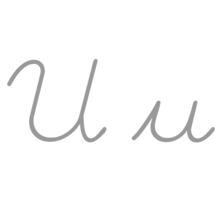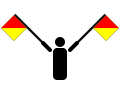U
|

U (named u /ˈjuː/, plural ues[1][2]) is the 21st letter and the fifth vowel in the ISO basic Latin alphabet.
History
The letter u ultimately comes from the Phoenician letter Waw by way of the letter y. See the letter y for details.
During the late Middle Ages, two forms of 'v' developed, which were both used for its ancestor 'u' and modern 'v'. The pointed form 'v' was written at the beginning of a word, while a rounded form 'u' was used in the middle or end, regardless of sound. So whereas 'valour' and 'excuse' appeared as in modern printing, 'have' and 'upon' were printed 'haue' and 'vpon'. The first recorded use of 'u' and 'v' as distinct letters is in a Gothic alphabet from 1386, where 'v' preceded 'u'. Printers eschewed capital 'U' into the 17th century and the distinction between the two letters was not fully accepted by the French Academy until 1762.[3]
Use in writing systems
English
In English, the letter ⟨u⟩ has four main pronunciations. There are "long" and "short" pronunciations. Short ⟨u⟩, found originally in closed syllables, most commonly represents /ʌ/ (as in 'duck'), though it retains its old pronunciation /ʊ/ after labial consonants in some words (as in 'put') and occasionally elsewhere (as in 'sugar'). Long ⟨u⟩, found originally in words of French origin (the descendent of Old English long u was respelled as ⟨ou⟩), most commonly represents /juː/ (as in 'mule'), reducing to /uː/ after ⟨r⟩ (as in 'rule') and sometimes (or optionally) after ⟨l⟩ (as in 'lute'), and after additional consonants in American English (see do–dew merger). (After ⟨s⟩, /sjuː, zjuː/ have assimilated to /ʃuː, ʒuː/.) In a few words, short ⟨u⟩ represents other sounds, such as /ɪ/ in 'business' and /ɛ/ in 'bury'.
The letter ⟨u⟩ is used in the digraphs ⟨au⟩ /ɔː/, ⟨ou⟩ (various pronunciations), and with the value of "long u" in ⟨eu⟩, ⟨ue⟩, and in a few words ⟨ui⟩ (as in 'fruit'). It often has the sound /w/ before a vowel in the sequences ⟨qu⟩ (as in 'quick'), ⟨gu⟩ (as in 'anguish'), and ⟨su⟩ (as in 'suave'), though it is silent in final -que (as in 'unique') and in many words with ⟨gu⟩ (as in 'guard').
Additionally, the letter ⟨u⟩ is used in text messaging and internet and other written slang to denote 'you', by virtue of both being pronounced /juː/.
One thing to note is that certain varieties of the English language (i.e. British English, Canadian English, etc.) use the letter U in words such as colour, labour, valour, etc.; however, in American English the letter is not used and said words mentioned are spelled as color and so on.
Other languages
In most languages that use the Latin alphabet, ⟨u⟩ represents the close back rounded vowel /u/ or a similar vowel.
In French orthography the letter represents the close front rounded vowel (/y/); /u/ is represented by ⟨ou⟩. In Dutch and Afrikaans, it represents either /y/, or a near-close near-front rounded vowel (/ʏ/); likewise the phoneme /u/ is represented by ⟨oe⟩. In Welsh orthography the letter can represent a long close front unrounded vowel (/i:/) or short near-close near-front unrounded vowel (/ɪ/) in Southern dialects. In Northern dialects, the corresponding long and short vowels are a long close central unrounded vowel (/ɨ:/) and a short lowered close central unrounded vowel (/ɨ̞/), respectively. /u:/ and /ʊ/ are represented by ⟨w⟩.
Other uses
The symbol 'U' is the chemical symbol for uranium.
In the context of Newtonian mechanics 'U' is the symbol for the potential energy of a system.
'u' is the symbol for the atomic mass unit and 'U' is the symbol for one Enzyme unit.
In IPA, the close back rounded vowel is represented by the lower case ⟨u⟩.
U is also the source of the mathematical symbol ∪, representing a union. It is used mainly for Venn diagrams and geometry.
It is used as for micro- in metric measurements as a replacement for the Greek letter μ (mu), of which it is a graphic approximation, when that Greek letter is not available, as in "um" for μm (micrometer).
Some universities, such as the University of Miami and the University of Utah, are locally known as "The U".
Related characters
Ancestors, descendants and siblings
- 𐤅: Semitic letter Waw, from which the following symbols originally derive
- Υ υ : Greek letter Upsilon, from which U derives
- V v : Latin letter V, from which U is directly descended
- W w : Latin letter W, which, like U, is descended from V
- Y y : Latin letter Y, also descended from Upsilon
- F f : Latin letter F, which also shares its roots with U, V, W, and Y
- У у : Cyrillic letter U, which also derives from Upsilon
- Ү ү : Cyrillic letter Ue
- V v : Latin letter V, from which U is directly descended
- Υ υ : Greek letter Upsilon, from which U derives
- IPA-specific symbols related to U: ʊ ɥ
- U with diacritics: Ŭ ŭ Ʉ ʉ Ụ ụ Ü ü Ú ú Ù ù Û û Ǔ ǔ Ű ű Ŭ ŭ Ư ư Ủ ủ Ū ū Ũ ũ Ų ų Ȕ ȕ
Ligatures and abbreviations
- ∪ : Union
- ∩ : Intersection, an upside-down upper case "U"
Computing codes
| Character | U | u | ||
|---|---|---|---|---|
| Unicode name | LATIN CAPITAL LETTER U | LATIN SMALL LETTER U | ||
| Encodings | decimal | hex | decimal | hex |
| Unicode | 85 | U+0055 | 117 | U+0075 |
| UTF-8 | 85 | 55 | 117 | 75 |
| Numeric character reference | U | U | u | u |
| EBCDIC family | 228 | E4 | 164 | A4 |
| ASCII 1 | 85 | 55 | 117 | 75 |
- 1 Also for encodings based on ASCII, including the DOS, Windows, ISO-8859 and Macintosh families of encodings.
Other representations
References
- ↑ "U", Oxford English Dictionary, 2nd edition (1989); Merriam-Webster's Third New International Dictionary of the English Language, Unabridged (1993)
- ↑ Brown & Kiddle (1870) The institutes of English grammar, page 19.
Ues is the plural of the name of the letter; the plural of the letter itself is rendered U's, Us, u's, or us. - ↑ Pflughaupt, Laurent (2008). Letter by Letter: An Alphabetical Miscellany. trans. Gregory Bruhn. Princeton Architectural Press. pp. 123–124. ISBN 978-1-56898-737-8. Retrieved 2009-06-21.
External links
 Media related to U at Wikimedia Commons
Media related to U at Wikimedia Commons The dictionary definition of U at Wiktionary
The dictionary definition of U at Wiktionary The dictionary definition of u at Wiktionary
The dictionary definition of u at Wiktionary


